庞德与中国诗歌
美国现代诗人庞德与中国古代诗歌

美国现代诗人庞德与中国古代诗歌摘要:埃兹拉·庞德(ezra pound)是美国著名的现代派诗人。
由他创立的“意象派诗歌”开辟了英美现代诗歌的先河。
时值本世纪初,人们对诗坛上从维多利亚时期以来的伤感情调和无病呻吟普遍感到不满。
正是在这种情况下,庞德以其独特清新的诗歌风格引起了诗坛的广泛瞩目。
中国古典文学对庞德的影响是巨大的,并且始终贯穿于他的诗歌创作的始终。
关键词:意象;庞德;中国文化;影响中图分类号:i222 文献标识码:a文章编号:1005-5312(2012)35-0003-02美国现代诗歌始自埃兹拉·庞德,但这位以勇于创新而闻名遐迩的现代诗人却与世界上历史最悠久的文化传统之一——中国古代诗歌结下了不解之缘。
1912年他在伦敦率先提出了意象主义这个诗歌概念,兴起了意象主义运动。
1914年他又编辑了《意象派诗集》,扩大了意象主义的影响。
此后,他的创作一直走着一条崭新的道路——为现代英语诗歌开辟的一条崭新的道路。
庞德曾把“意象”定义为“一刹那间思想和感情的复合体”。
据他自述他这种创作方法正式受到了中国古代诗歌的影响。
在他的一生中,中国古典文学始终对他的创作起着重大的影响。
庞德最早接触到中国文学是在本世纪初,当时瞿理斯(herbert giles)的《中国文学史》(a history of chinese literature)就引起了他很大兴趣,他对书中所录的刘彻的《落叶哀蝉曲》大为赞赏,不久就出现在他的诗集中。
对此,可以加以比较:刘彻:罗袂兮无声,玉樨兮尘生。
/虚房冷而寂寞,落叶依于重肩。
/望彼美之女兮安得,感余心之未宁。
庞德:绸裙的,瑟再不复闻,灰尘飘落在宫苑里,听不到脚步声,乱叶飞旋着,静静地堆积,她,我心中的欢乐,睡在下面。
一片潮湿的树叶粘在门槛上。
the rusting of silk is discontinued/ dust drifts over the courtyard/ there is no sound of footfall,and the leaves,/ scurry into heaps and lie still;/ and she the rejoicer of the heart is beneath’em,/ a wet leaf that clings to the thresold.庞德改作的前两句是对原文的忠实翻译。
庞德诗学与中国现当代诗歌
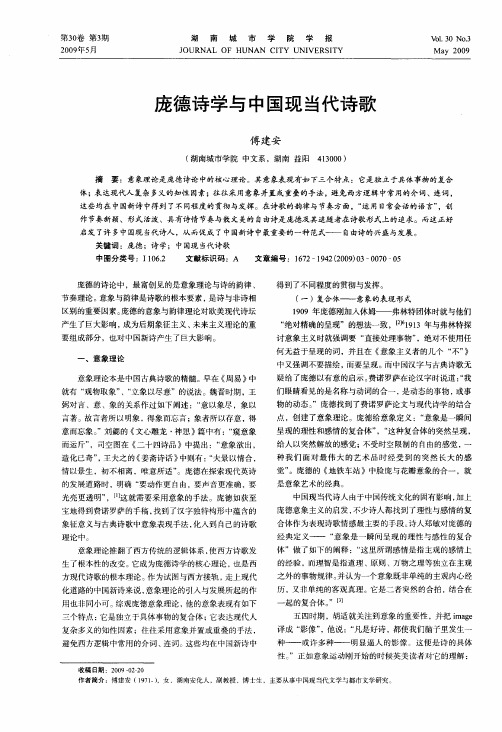
之外的事物规律。 认为一个 意象 既非单纯 的主观 内心经 并 历 ,又非单纯 的客观真理 。它是二者突然的合拍 ,结合在
一
起的复合体。 3 ”【 ]
五 四时期 ,胡适就关注到意象的重要 性 ,并把 i g ma e
中又强调不要描绘 , 而要呈现。而中国汉字与古典诗歌无 疑给 了庞德 以有意 的启示。 费诺 罗萨在论汉字时说道 :我 “
区别的重要因素。 庞德 的意象与韵律理论对欧美现代诗坛 产生 了巨大影响 , 为后期象征主义 、 成 未来主义理论的重
要组成部分 ,也对中国新诗产生 了巨大影响 。
一
物 的动态 。 ”庞德找到了费诺 罗萨论文 与现代诗学的结合
点 ,创建 了意象理论 。庞德给意象定义 :“ 意象是一瞬间 呈现 的理性和感情 的复合体” 这种 复合体 的突然呈现 , ,“
给人 以突然解放 的感觉 ; 不受时空限制的 自由的感觉 , 一
意而忘象 。 ”刘勰 的 《 文心雕龙 ・ 神思 》 中有 :“ 篇 窥意象 而运 斤” ,司空图在 《 二十 四诗品 》中提出 :“ 意象欲 出, 造化 已奇 ” 王 夫之 的 《 , 姜斋诗话 》 中则有 : 夫景以情合 , “
、
意象理论
意象理论本是中国古 典诗歌 的精髓 。 在 《 早 周易 》中
就有 “ 观物取象” 立象以尽意”的说法。魏晋时期 ,王 、“ 弼对言 、意 、象的关系作过如下阐述 :“ 意以象尽 ,象以 言著 。故言者所 以明象 , 得象 而忘 言;象者所 以存意 ,得
们 眼睛看见的是名称与动词的合 一 , 动态 的事物 , 是 或事
庞德《神州集》李白诗词契合论文

庞德的《神州集》与李白诗词的契合摘要:诺贝尔文学奖获得者、英国诗人艾略特说,现代主义诗歌巨匠埃兹拉?庞德对英语诗歌革命最持久、最具决定性的贡献,就是他翻译的中国古典诗词,其中主要是李白诗词。
艾略特认为庞德发明了中国的古典诗词。
庞德研究了中国古典诗词,研究了李白,然后借助翻译完成了20世纪现代英语诗歌最为深刻的语言革命。
本文将以庞德翻译的中国古诗词集《神州集》为切入点,探讨李白诗词对庞德诗词翻译及创作的影响。
关键词:李白诗词;庞德;《神州集》中图分类号:i06 文献标识码:a文章编号:1009-0118(2012)07-0243-02一、引言1908年前后,受法国象征主义诗歌影响,以埃兹拉?庞德为首的西方诗人们,发起了一场旨在改变英国维多利亚王朝颓靡诗风的新诗运动,推动了英美两国诗歌向现代诗的转变。
意象派是新诗运动中最引人注目,也是对美国现代诗影响最大的一个派别。
为了破除旧传统,为了开创新诗风,美国新诗人吸收了大量国外影响,尤其是中国诗的影响。
杰出的新诗人之一玛丽安.莫尔认为:“新诗似乎是作为日本诗——或许不如说是中国诗的一个强化形式而存在的……”这就是说,新诗运动本身就是一场中国热。
意象派诗歌的创始人庞德也常说,只要读一下他译的中国诗,“就可以明白什么是意象主义”。
另一个意象派成员约翰?哥尔德?弗莱契则说,他之所以参加意象派就是因为意象派意味着中国风:“正是因为中国影响,我才成为一个意象派,而且接受了这个名称的一切含义。
”意象派所留下的主要文化遗产之一就是他们对中国诗的介绍,其中最主要的译作就庞德的《神州集》(cathay),又译《中国诗集》或《华夏集》。
《神州集》收录了19首中国古诗词,其中11首是李白的诗,足以证明庞德对中国古诗的认识和了解多来自于李白的诗,李白的诗对意象派诗歌产生了极大的影响。
本文将从庞德和李白诗词之间的纽带——《神州集》切入,考察李白诗与庞德现代主义诗学观念相吻合的因素,进而证实李白诗词对庞德及其创立的意象派诗歌的影响。
庞德与中国古诗
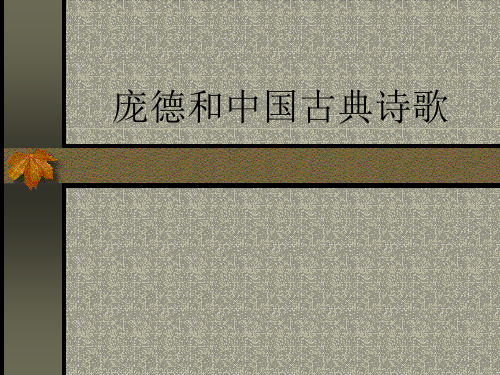
And the bamboos speak as if weeping.
雨;空江;在旅途,
冷云闪烁,夕暮逢大雨
屋檐下挂着一个灯笼。 芦苇沉沉;垂首;
Dig field, eat of the grain
Imperial power, and to us what it is?
from Pound’s The Cantos, 49.
艾思柯译
寂寞骊山道,清秋草木黄。
Still, silent, Li Mountain road,
翠竹如诉如泣。
Autumn moon; hills rise about lakes Against sunset Evening is like a curtain of cloud,
A blurr above ripples; and through it
Sharp long spikes of the cinnamon, A cold tune amid reed.
Drawing sword, cut into water, water
again flows. Raise cup, quench sorrow, sorrow again sorrow.
日出而作,日入而息; 凿井而饮,耕田而食,
帝力于我有何哉?
Sun up, work Sun down, rest Dig well, drink of the water
Cathay (《神州集》)
1914年,庞德在整理费诺罗萨笔记的基础上,
试论埃兹拉·庞德对中国古典诗歌的解读与创译试论埃兹拉·庞德对中国古典诗歌的解读与创译
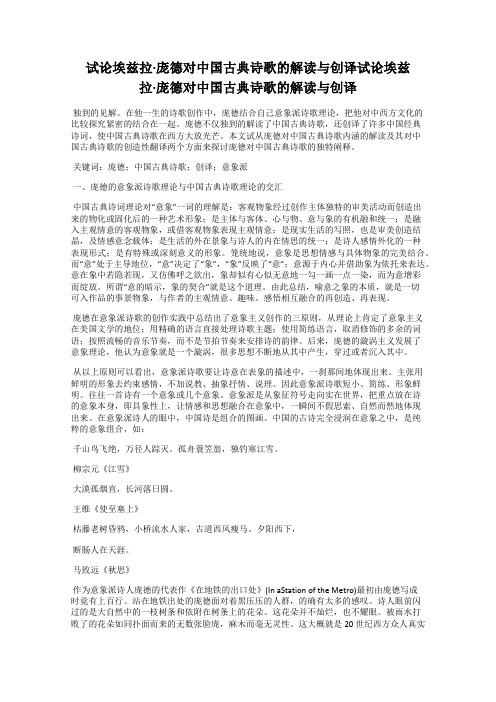
试论埃兹拉·庞德对中国古典诗歌的解读与创译试论埃兹拉·庞德对中国古典诗歌的解读与创译独到的见解。
在他一生的诗歌创作中,庞德结合自己意象派诗歌理论,把他对中西方文化的比较探究紧密的结合在一起。
庞德不仅独到的解读了中国古典诗歌,还创译了许多中国经典诗词,使中国古典诗歌在西方大放光芒。
本文试从庞德对中国古典诗歌内涵的解读及其对中国古典诗歌的创造性翻译两个方面来探讨庞德对中国古典诗歌的独特阐释。
关键词:庞德;中国古典诗歌;创译;意象派一、庞德的意象派诗歌理论与中国古典诗歌理论的交汇中国古典诗词理论对“意象”一词的理解是:客观物象经过创作主体独特的审美活动而创造出来的物化或固化后的一种艺术形象;是主体与客体、心与物、意与象的有机融和统一;是融入主观情意的客观物象,或借客观物象表现主观情意;是现实生活的写照,也是审美创造结晶,及情感意念载体;是生活的外在景象与诗人的内在情思的统一;是诗人感情外化的一种表现形式;是有特殊或深刻意义的形象。
笼统地说,意象是思想情感与具体物象的完美结合。
而“意”处于主导地位,“意”决定了“象”,“象”反映了“意”;意源于内心并借助象为依托来表达。
意在象中若隐若现,又仿佛呼之欲出,象却似有心似无意地一勾一画一点一染,而为意增彩而绽放。
所谓“意的暗示,象的契合”就是这个道理。
由此总结,喻意之象的本质,就是一切可入作品的事景物象,与作者的主观情意、趣味、感悟相互融合的再创造、再表现。
庞德在意象派诗歌的创作实践中总结出了意象主义创作的三原则,从理论上肯定了意象主义在美国文学的地位:用精确的语言直接处理诗歌主题;使用简练语言,取消修饰的多余的词语;按照流畅的音乐节奏,而不是节拍节奏来安排诗的韵律。
后来,庞德的漩涡主义发展了意象理论,他认为意象就是一个漩涡,很多思想不断地从其中产生,穿过或者沉入其中。
从以上原则可以看出,意象派诗歌要让诗意在表象的描述中,一刹那间地体现出来。
中国古典诗歌美学与庞德现代主义诗学
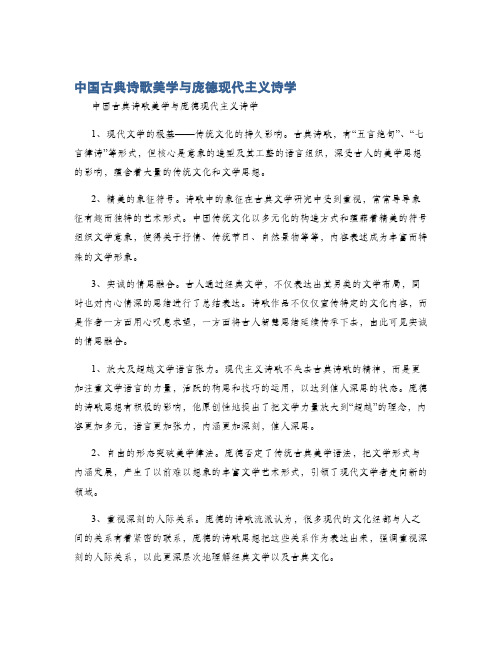
中国古典诗歌美学与庞德现代主义诗学中国古典诗歌美学与庞德现代主义诗学1、现代文学的根基——传统文化的持久影响。
古典诗歌,有“五言绝句”、“七言律诗”等形式,但核心是意象的造型及其工整的语言组织,深受古人的美学思想的影响,蕴含着大量的传统文化和文学思想。
2、精美的象征符号。
诗歌中的象征在古典文学研究中受到重视,常常导导象征有趣而独特的艺术形式。
中国传统文化以多元化的构造方式和蕴藉着精美的符号组织文学意象,使得关于抒情、传统节日、自然景物等等,内容表述成为丰富而特殊的文学形象。
3、实诚的情思融合。
古人通过经典文学,不仅表达出其另类的文学布局,同时也对内心情深的思绪进行了总结表达。
诗歌作品不仅仅宣传特定的文化内容,而是作者一方面用心叹息求望,一方面将古人智慧思绪延续传承下去,由此可见实诚的情思融合。
1、放大及超越文学语言张力。
现代主义诗歌不失去古典诗歌的精神,而是更加注重文学语言的力量,活跃的构思和技巧的运用,以达到催人深思的状态。
庞德的诗歌思想有积极的影响,他原创性地提出了把文学力量放大到“超越”的理念,内容更加多元,语言更加张力,内涵更加深刻,催人深思。
2、自由的形态突破美学律法。
庞德否定了传统古典美学语法,把文学形式与内涵发展,产生了以前难以想象的丰富文学艺术形式,引领了现代文学者走向新的领域。
3、重视深刻的人际关系。
庞德的诗歌流派认为,很多现代的文化经都与人之间的关系有着紧密的联系,庞德的诗歌思想把这些关系作为表达出来,强调重视深刻的人际关系,以此更深层次地理解经典文学以及古典文化。
综上所述,中国古典诗歌美学包含着传统文化的持久影响,万象符号的精美造型以及实诚情思融合;而庞德现代主义诗学则以放大文学张力,自由突破美学律法及重视深刻的人际关系的方式构建了更加丰富的主题表达,影响着现代文学的发展。
庞德与许渊冲中国古典诗歌翻译理论比较[论文]
![庞德与许渊冲中国古典诗歌翻译理论比较[论文]](https://img.taocdn.com/s3/m/480fe3721711cc7931b71620.png)
庞德与许渊冲中国古典诗歌翻译理论比较摘要:中国古典诗歌是世界文学宝库里一颗璀璨的明珠。
多年来,中外学者不仅在实践方面对中国古诗的翻译做出了巨大的贡献,而且还就中国古典诗歌的翻译理论提出了各自精辟的见解。
本文通过比较庞德和许渊冲的译诗,探讨他们各自的翻译理论,旨在为中国古诗英译研究提出新的思路和研究视角,为中国古诗英译的发展贡献自己的力量。
关键词:庞德许渊冲中国古典诗歌翻译理论1.引言中国古典诗歌是中华民族文化之瑰宝,中国文学之精髓,其文化内涵丰富,具有独特的艺术风格。
因此,古诗英译对中国古典文学的对外传播和中西文化交流具有重大意义。
早期,古诗翻译主要有以下三种形式:翟理斯为代表的意译法,庞德的创造性翻译法,以及亚瑟·韦利的直译法。
当代中国,翁显良和许渊冲则是这一领域的佼佼者。
前者倾向于归化翻译法,后者比较注重译诗的韵律。
不论何种翻译方法,这些学者都以自己与众不同的翻译理论和技巧获得了很大的成功。
本文通过对比分析庞德和许渊冲所翻译的具体文本,对二者的翻译理论进行比较。
相同的文本,二者却创造出大相径庭的译文,而他们各自的译文在不同的时代又都取得了巨大的成功。
可见,翻译过程中,译者可以根据不同的翻译对象及翻译目标,选择翻译策略,译出符合要求的译文,最终实现翻译目的。
2. 庞德、许渊冲翻译理论比较庞德是意象派的灵魂人物,他早年对中国古典诗歌十分推崇,是对中国诗歌最热情的美国现代诗人。
他认为文学爱好者不仅能从翻译实践中得到训练,而且能从语言本身得到益处。
他主张以自由诗体翻译中国古诗。
译诗应尽量准确、简洁,保留原诗中“不可破坏的”部分。
(pound, 1913: 707)笔者认为,庞德的翻译实质上是一种“忠实的创造”。
所谓“忠实”,即翻译要在意义、风格及氛围上忠实原文。
所谓“创造”,即他认为“诗歌的内在思想既可以用韵律诗体也可以用无韵诗体展现出来”。
然而,这些“创造”是在他忠实的语言翻译的限度之内的。
庞德《A Girl》与李商隐《杂歌谣辞·李夫人歌》的对比研究
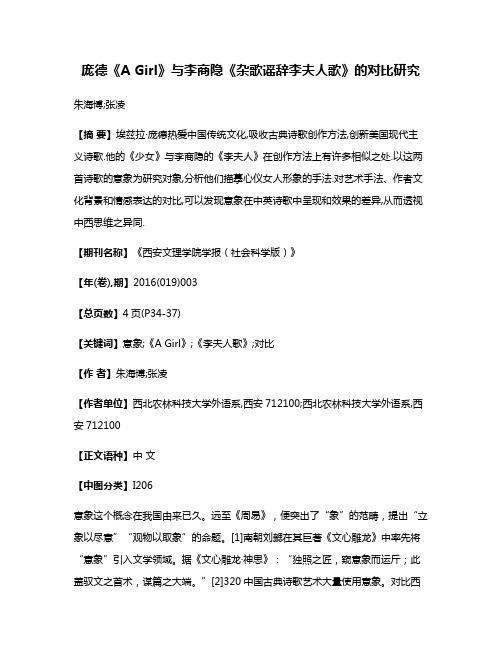
庞德《A Girl》与李商隐《杂歌谣辞李夫人歌》的对比研究朱海博;张凌【摘要】埃兹拉·庞德热爱中国传统文化,吸收古典诗歌创作方法,创新美国现代主义诗歌.他的《少女》与李商隐的《李夫人》在创作方法上有许多相似之处.以这两首诗歌的意象为研究对象,分析他们描摹心仪女人形象的手法.对艺术手法、作者文化背景和情感表达的对比,可以发现意象在中英诗歌中呈现和效果的差异,从而透视中西思维之异同.【期刊名称】《西安文理学院学报(社会科学版)》【年(卷),期】2016(019)003【总页数】4页(P34-37)【关键词】意象;《A Girl》;《李夫人歌》;对比【作者】朱海博;张凌【作者单位】西北农林科技大学外语系,西安712100;西北农林科技大学外语系,西安712100【正文语种】中文【中图分类】I206意象这个概念在我国由来已久。
远至《周易》,便突出了“象”的范畴,提出“立象以尽意”“观物以取象”的命题。
[1]南朝刘勰在其巨著《文心雕龙》中率先将“意象”引入文学领域。
据《文心雕龙·神思》:“独照之匠,窥意象而运斤;此盖驭文之首术,谋篇之大端。
”[2]320中国古典诗歌艺术大量使用意象。
对比西方,从亚里士多德开始,也提出了“意象”的概念。
[1]西方文论抒情也借助意象手法。
[2]321庞德作为美国现代主义诗歌奠基人,曾积极吸收中国古典诗歌意象特色,因此意象研究也是庞德诗歌研究的重点。
在中国文化走出去的时代背景下,有必要对比分析英汉诗歌的意象特征和描摹手法。
李商隐,字义山,晚唐人,因受“牛李党争”的影响,被人排挤,潦倒终身。
他创作的《李夫人歌》,看似一首悼念亡妻王氏的诗作,但其不仅有个人情感,更有对时代的哀叹。
在李商隐的一系列《无题》诗中,以“夕阳无限好,只是近黄昏“表现自己登临乐游原的伤感,就曾有人称之为李唐王朝“唱挽歌式的凄惶”。
而文人对于自己理想政治的向往和执著,对于理想人格的敬仰和追求,恰恰显示出其人格的高尚。
谈庞德对古诗《长干行》翻译

谈庞德对古诗《长干行》的翻译摘要:李白的《长干行》是一首被人们广为流传的乐府诗。
埃兹拉·庞德运用意象的方法对《长干行》做了翻译,被称为20世纪美国最美译诗。
庞德并没有完全遵从原诗,而是在形式和意义上对原诗进行了一些创造性的处理,本文分析了《长干行》英文翻译与原诗的差异,并从语言及文化等方面进行解释,最后从历史的角度对庞德的英文翻译版本做出总结。
关键词:《长干行》庞德翻译中西差异李白的《长干行》是一首被人们广为流传的乐府诗,这首诗描写了商妇的爱情和离别。
诗以商妇的自白,用缠绵婉转的笔调,抒写了她对远出经商丈夫的真挚的爱和深深的思念。
不仅因为其鲜明的节奏感,更是因为诗中描写的美好意境,让读者身临其境,流连忘返。
美国诗人埃兹拉.庞德是西方“意象主义”运动的发起人,他主张尝试不同的诗体,注重用简洁凝练的语句以及意象来表达内容。
他对《长干行》的翻译不拘泥于诗歌的外在形式,运用了各种意象对原诗进行了创造性地翻译,实现了诗歌的再创作。
意象派触发起现代美国诗人对中国诗持久不衰的热情,推动英美诗歌朝现代派方向转变。
在庞德看来,翻译不应该是字对字的文法翻译,因为如果这样,文学作品就会丧失原语作品本身的时间、地点与当代相关联所应有的生机与活力;相反,翻译应该是一种阐释,译者通过阐释创造新的诗歌。
庞德在翻译过程中并没有完全遵从原诗,所以译诗与原诗在意义方面有一些差异。
1、译诗对原诗在文化因素上的改动首先,庞德将译诗的题目写为the river-merchant. s wife: a letter,他将原诗理解为河商妻子为了表达思念之情给丈夫写的一封信。
而对古诗稍有研究的人都知道这是多情少妇的内心独白,中国这样的古诗并不少见。
中国人历来感情含蓄,古代女子尤其如此。
并且在古代由于礼教的约束,女子是不会向丈夫倾吐如此露骨的相思之情的。
因此,“a letter”用在此处并不恰当。
诗的第二句:“郎骑竹马来,绕床弄青梅”庞德由于对中国文化知识的缺乏,不了解把竹竿当作马骑是男孩子通常玩的游戏。
神州集--庞德英汉

《神州集》共收中国古典诗歌十九首。
其中包括《诗经·小雅。
采薇》,《汉乐府陌上桑》,《古诗十九首·青青河畔草》,郭璞的《游仙诗》,陶潜的《停云》,王维的《送元二使安西》,卢照邻的《长安古意》以及李白的《长干行》、《江上吟》、《侍从宜春苑奉诏赋龙池柳包初青听新莺百嗽歌》、《古风十八·天津》、《古风十四·胡关》、《忆旧游寄憔郡元参军》、《送友人入蜀》、《登金陵凤凰台》、《黄鹤楼送孟浩然之广陵》、《送友人》、《玉阶怨》、《古风六·代马》。
第一首《诗经·小雅·采薇》采薇采薇,薇亦作止。
曰归曰归,岁亦莫止。
靡室靡家,犹脸之故。
不逞启居,犹脸之故。
采薇采薇,薇亦柔止。
曰归曰归,心亦忧止。
忧心烈烈,载饥载渴。
我戍未定,靡使归聘。
采薇采薇,薇亦刚止。
曰归曰归,岁亦阳止。
王室靡篮,不逞启处。
忧心孔疚,我行不来。
彼尔维何,维常之华。
彼路斯何,君子之车。
戎车既驾,四牡业业。
岂敢定居,一月三捷。
驾彼四牡,四牡骇骇。
君子所依,小人所排。
四牡翼翼,象饵鱼服。
岂不日戒,犹脸孔棘。
昔我往矣,杨柳依依。
今我来思,雨雪霏霏。
行道迟迟,载渴载饥。
我心悲伤,莫知我哀。
1 SONG OF THE BOWMAN OF SHUHere we are, picking the first fern-shootsAnd saying: When shall we get back to our country?Here we are because we have the Ken-nin for our foemen,We have no comfort because of these Mongols.We grub the soft fern-shoots,When anyone says "Return," the others are full of sorrow. Sorrowful minds, sorrow is strong, we are hungry and thirsty. Our defense is not yet made sure, no one can let his friend return. We grub the old fern-stalks.We say: Will we be let to go back in October?There is no ease in royal affairs, we have no comfort.Our sorrow is bitter, but we would not return to our country. What flower has come into blossom?Whose chariot? The General's.Horses, his horses even, are tired. They were strong.We have no rest, three battles a month.By heaven, his horses are tired.The generals are on them, the soldiers are by them.The horses are well trained, the generals have ivory arrows and quivers ornamented with fish-skin.The enemy is swift, we must be careful.When we set out, the willows were drooping with spring,We come back in the snow,We go slowly, we are hungry and thirsty,Our mind is full of sorrow, who will know of our grief? by Bunno — Reputedly 1100 B.C第二首《古诗十九首·青青河畔草》《青青河边草》无名氏青青河畔草,郁郁园中柳。
《华夏集》诗歌

《华夏集》诗歌
《华夏集》是美国诗人埃兹拉·庞德翻译的中国古典诗歌文集。
庞德在诗集中对中国古诗采取了“边译边创”的译介模式,他的译诗主要是在理解原诗的基础上进行的诗歌再创作。
以下是《华夏集》中的一些诗歌:
《长干行》
妾发初覆额,折花门前剧。
郎骑竹马来,绕床弄青梅。
同居长干里,两小无嫌猜。
《送友人》
青山横北郭,白水绕东城。
此地一为别,孤蓬万里征。
浮云游子意,落日故人情。
挥手自兹去,萧萧班马鸣。
《黄鹤楼送孟浩然之广陵》
故人西辞黄鹤楼,烟花三月下扬州。
孤帆远影碧空尽,惟见长江天际流。
这些诗歌都是庞德从中国古典诗歌中选取并进行翻译的,展示了中国古诗的魅力和美学特点。
同时,庞德的翻译也融入了他个人的现代主义诗学创作理念,使得《华夏集》在英语世界引起了极大反响。
如需更多信息,可以阅读埃兹拉·庞德翻译的《华夏集》原著或相关评论。
中国古典诗歌对庞德诗歌创作的影响
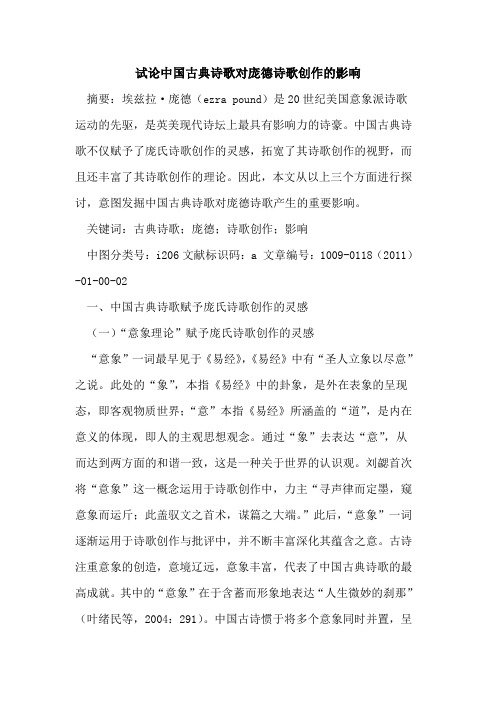
试论中国古典诗歌对庞德诗歌创作的影响摘要:埃兹拉·庞德(ezra pound)是20世纪美国意象派诗歌运动的先驱,是英美现代诗坛上最具有影响力的诗豪。
中国古典诗歌不仅赋予了庞氏诗歌创作的灵感,拓宽了其诗歌创作的视野,而且还丰富了其诗歌创作的理论。
因此,本文从以上三个方面进行探讨,意图发掘中国古典诗歌对庞德诗歌产生的重要影响。
关键词:古典诗歌;庞德;诗歌创作;影响中图分类号:i206文献标识码:a 文章编号:1009-0118(2011)-01-00-02一、中国古典诗歌赋予庞氏诗歌创作的灵感(一)“意象理论”赋予庞氏诗歌创作的灵感“意象”一词最早见于《易经》,《易经》中有“圣人立象以尽意”之说。
此处的“象”,本指《易经》中的卦象,是外在表象的呈现态,即客观物质世界;“意”本指《易经》所涵盖的“道”,是内在意义的体现,即人的主观思想观念。
通过“象”去表达“意”,从而达到两方面的和谐一致,这是一种关于世界的认识观。
刘勰首次将“意象”这一概念运用于诗歌创作中,力主“寻声律而定墨,窥意象而运斤;此盖驭文之首术,谋篇之大端。
”此后,“意象”一词逐渐运用于诗歌创作与批评中,并不断丰富深化其蕴含之意。
古诗注重意象的创造,意境辽远,意象丰富,代表了中国古典诗歌的最高成就。
其中的“意象”在于含蓄而形象地表达“人生微妙的刹那”(叶绪民等,2004:291)。
中国古诗惯于将多个意象同时并置,呈现在读者面前,颇有利用蒙太奇手法产生的效果。
如马致远的《天净沙?秋思》:“古藤老树昏鸦,小桥流水人家,古道西风瘦马。
夕阳西下,断肠人在天涯。
”作者将十二个意象并置叠加,呈现出一幅带有悲凉色彩的画面,刻画出一个在黄昏时分漂泊于西风古道上的游子形象。
庞氏诗歌创作之中大量意象的并置,就是中国古典诗歌“意象理论”赋予其诗歌创作的灵感的。
(二)中国古典诗风赋予西方意象派诗歌创作的灵感西方意象派的产生最初是对当时诗坛文风的一种反驳。
庞德曾将中国文学史中所译的汉诗
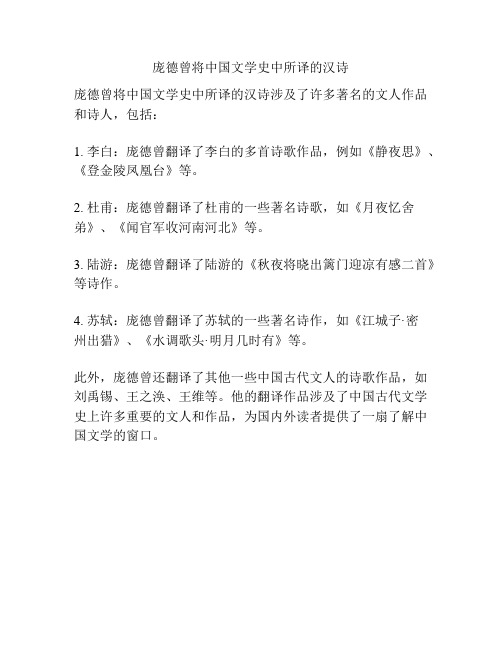
庞德曾将中国文学史中所译的汉诗
庞德曾将中国文学史中所译的汉诗涉及了许多著名的文人作品和诗人,包括:
1. 李白:庞德曾翻译了李白的多首诗歌作品,例如《静夜思》、《登金陵凤凰台》等。
2. 杜甫:庞德曾翻译了杜甫的一些著名诗歌,如《月夜忆舍弟》、《闻官军收河南河北》等。
3. 陆游:庞德曾翻译了陆游的《秋夜将晓出篱门迎凉有感二首》等诗作。
4. 苏轼:庞德曾翻译了苏轼的一些著名诗作,如《江城子·密
州出猎》、《水调歌头·明月几时有》等。
此外,庞德曾还翻译了其他一些中国古代文人的诗歌作品,如刘禹锡、王之涣、王维等。
他的翻译作品涉及了中国古代文学史上许多重要的文人和作品,为国内外读者提供了一扇了解中国文学的窗口。
Ezra Pound庞德翻译理论与汉诗翻译完整版资料
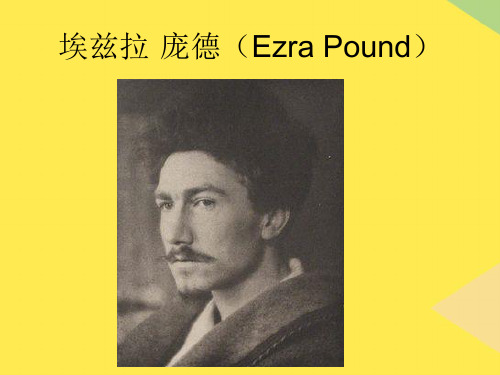
• 1931 How to Read, essays • 1933 ABC of Economics, essays • 1933 Cavalcanti, three-act opera • 1934 Eleven New Cantos: XXXI-XLI, poems (New York) • 1934 Homage to Sextus Propertius, poems (London) • 1934 ABC of Reading, essays • 1935 Make It New, essays • 1936 Chinese written character as a medium for poetry, by Ernest
• 意象派的产生最初是对当时诗坛文风的一种反拨。首先, 在19世纪后期英国文坛,象征主义、唯美主义与浪漫主义 结成一体,形成新浪漫主义。意象派是在其基础上演变而 成的。到20世纪初,传统诗歌,尤其是浪漫主义、维多利 亚诗风蜕化成无病呻吟、多愁善感和伦理说教,只是“对 济慈和华兹华斯模仿的模仿”。庞德及其意象派提出“反 常规”“革新”地进行诗歌创作的主张。其次,20世纪初 柏格森热流行,这是自叔本华以来非理性主义哲学思想在 文学界影响的延伸。意象派的开创者休姆就直接受教于柏 格森。柏格森的直觉主义、生命哲学全盘为意象派所接受, 成为其主要的理论依据和哲学基础。意象派诗特别强调意 象和直觉的功能。同时,象征主义诗歌流派为意象派开创 了新诗创作新路,尤其是诗的通感、色彩及音乐性,给意 象派以极大的启发。
• 1918: Pavannes and Divisions, prose (New York) • 1919 Quia Pauper Amavi, poems (London) • 1919 The Fourth Canto, poems • 1920 Umbra, poems and translations (London) • 1920 Hugh Selwyn Mauberley, poems (London) • 1921 Poems, 1918–1921, poems (New York) • 1922 The Natural Philosophy of Love, by Rémy de Gourmont,
庞德 李白 长干行
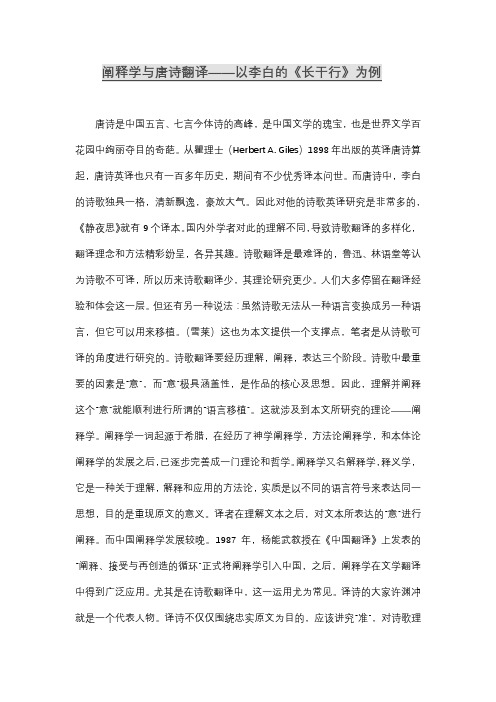
唐诗是中国五言、七言今体诗的高峰,是中国文学的瑰宝,也是世界文学百花园中绚丽夺目的奇葩。
从瞿理士(Herbert A. Giles)1898年出版的英译唐诗算起,唐诗英译也只有一百多年历史,期间有不少优秀译本问世。
而唐诗中,李白的诗歌独具一格,清新飘逸,豪放大气。
因此对他的诗歌英译研究是非常多的,《静夜思》就有9个译本。
国内外学者对此的理解不同,导致诗歌翻译的多样化,翻译理念和方法精彩纷呈,各异其趣。
诗歌翻译是最难译的,鲁迅、林语堂等认为诗歌不可译,所以历来诗歌翻译少,其理论研究更少。
人们大多停留在翻译经验和体会这一层。
但还有另一种说法:虽然诗歌无法从一种语言变换成另一种语言,但它可以用来移植。
(雪莱)这也为本文提供一个支撑点,笔者是从诗歌可译的角度进行研究的。
诗歌翻译要经历理解,阐释,表达三个阶段。
诗歌中最重要的因素是“意”,而“意”极具涵盖性,是作品的核心及思想。
因此,理解并阐释这个“意”就能顺利进行所谓的“语言移植”。
这就涉及到本文所研究的理论——阐释学。
阐释学一词起源于希腊,在经历了神学阐释学,方法论阐释学,和本体论阐释学的发展之后,已逐步完善成一门理论和哲学。
阐释学又名解释学,释义学,它是一种关于理解,解释和应用的方法论,实质是以不同的语言符号来表达同一思想,目的是重现原文的意义。
译者在理解文本之后,对文本所表达的“意”进行阐释。
而中国阐释学发展较晚。
1987年,杨能武教授在《中国翻译》上发表的“阐释、接受与再创造的循环”正式将阐释学引入中国,之后,阐释学在文学翻译中得到广泛应用。
尤其是在诗歌翻译中,这一运用尤为常见。
译诗的大家许渊冲就是一个代表人物。
译诗不仅仅围绕忠实原文为目的,应该讲究“准”,对诗歌理解准确,英语表达用词贴切,精当。
(丛滋杭)本文以李白的《长干行》为例,从不同的译本看译者不同理解和翻译。
诗歌翻译是文化传播与交流的纽带,所以应该提倡并鼓励这项新事业。
本文分为三部分:第一部分讲述阐释学的起源及发展;第二部分简介李白及其诗歌的历史地位及影响;第三部分讨论《长干行》的不同译本,看译者的不同阐释。
庞德的《神州集》与中国古典诗歌现代化
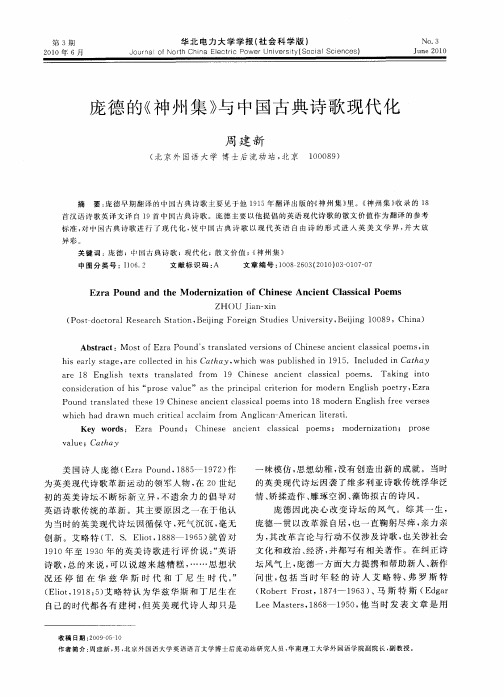
第 3期 21 0 0年 6月
华北 电 力大学 学报 ( 会 科 学版 ) 社
J u n of hChn lc c P we ie st S c a cin e } o a【 r ia Ee ti o Unv i r No t r r r y( o i I e c s S
情、 矫揉 造作 、 雕琢 空洞 、 饰拟 古 的诗风 。 藻 庞 德 因此 决 心 改 变 诗坛 的 风气 。综 其 一 生 ,
初 的英美诗 坛 不 断标 新 立 异 , 遗 余 力 的 倡 导对 不
英语 诗歌传 统 的革新 。其 主要 原 因之一 在 于他认
为 当时 的英 美 现代诗 坛 因循保 守 , 死气 沉沉 , 无 毫
创新 。艾 略特 ( T.S l t 1 8 — 1 6 ) 曾 对 .E i , 8 8 9 5 就 o 11 9 0年 至 l 3 9 0年的 英美 诗歌 进 行 评 价说 : 英语 “ 诗歌 , 的来说 , 以说 越 来 越糟 糕 , 总 可 …… 思 想状 况 还 停 留 在 华 兹 华 斯 时 代 和 丁 尼 生 时 代 。 ” ( l t1 1 : ) 略特 认 为华 兹 华 斯 和 丁 尼 生在 E i ,9 8 5 艾 o
中国古诗与庞德的理解

摘要:中国文字和中国人的思维决非像西方曾经认为的那样仅仅处于低级的感性水平上,基于对言、象、意关系的独特领悟,中国诗歌把意象营构当成了自己的一大任务。
庞德从反浪漫主义的期待视野出发,在中国古诗中挖掘出了异常丰富的思想养料,借以掀起了意象派诗歌运动,为西方现当代文学的形成与发展作出了开拓性的贡献。
尽管庞德的意象诗歌并不具备中国古诗背后所依托的哲学美学底蕴,避免不了肤浅而短命的可悲结局,但东西方文化交流史上的这一次伟大碰撞却是值得我们永远纪念的,文化相对于现实而言的超越性质在其中得到了卓越的证明。
本文采用先进的比较文学研究方法,着眼于广博的知识展示和谨严的理论思辩,主要探讨了三个问题:中国古典美学的诸多特性;庞德对中国古诗的误读式理解;中国诗歌的好坏分类与庞德的是非得失。
关键词:中国古诗;庞德;意象主义;理解似乎确如今道友信所言,现代东西方的艺术发展具有一种逆现象:“一方在发现着他方的过去,他方也在自律性地发现一方的过去。
”(1)本文就是为了从理论上考察这种逆现象在意象派诗歌运动的领袖埃兹拉·庞德(ezra pound)身上的发生过程而作的:首先,我们必须搞清楚中国古典美学的特征;其次,我们要介绍庞德对中国古诗的误读式理解;最后,我们将结合中国诗歌的地位问题分析庞德等人的得失。
一作为常识,谁都知道汉字属于表意文字(ideogram)。
不过尤其在西方,表意文字又经常被与象形文字(hieroglyph)混为一谈,人们因而以讹传讹地认为汉字是幅简洁的图画。
固然这二者是有一定联系的,造字六书之中即有象形;而且从起源上讲,象形大约还是汉字发展的第一个阶段。
许慎写道:“古者庖牺氏之王天下也,仰则观象于天,俯则观法于地,视鸟兽之文与地之宜,近取诸身,远取诸物,于是始作《易》八卦以垂宪象。
及神龙氏结绳为治,而统其事,庶业其繁,饰伪萌生。
黄帝之史苍颉,见鸟兽蹄迒之迹,知分理之可相别异也,初造书契。
”但事情也仅仅如此。
庞德与汉字的诗性特征

庞德与汉字的诗性特征【摘要】作为美国现代诗歌之父,庞德在中国古典文学和汉语言的影响下,逐渐形成了一种独特的汉字情结。
他不是汉学家,却完成了《华夏集》和《诗章》的翻译巨著,将汉文化传播到西方,并引起了20世纪“中国风”的盛行。
两部著作让庞德在整个美国的中国文化传播过程中占据了重要的地位,他对汉字的痴迷、对中国古典文化的热爱都结晶在了这两部著作中。
诗性的文字、不拘一格的诗歌风格以及诗性思维的汉字文化,这些在庞德看来都源于汉字的奇特之处——汉字是诗化的语言。
【关键词】汉字;诗性;庞德;《华夏集》;《诗章》作为20世纪的美国诗人,庞德以意象派诗歌创作而家喻户晓,而庞德也是20世纪对中国诗最热情的诗人,同样对于汉字的痴迷造就了庞德的诗作《华夏集》和《诗章》,这两本著作也成为后世西方学者研究中国文化的必读之作。
在品读这两部著作时我们可以从庞德的译作中看到他在诗歌的创作中借鉴了大量的中国汉字,不仅借鉴了汉字,更重要的是从翻译中我们深入了解到了汉字的诗性思维。
一、庞德的汉字情结庞德的汉字情结与厄尔斯特·费诺罗萨有着密切的关系。
1908年,厄尔斯特·费诺罗萨去世,他的妻子为了能将费诺罗萨的中国诗笔记出版,于是她便试图找到一个合适的诗人能将他丈夫的笔记翻译出来,这个人就是庞德。
虽然庞德很早前就接触过汉字,但他真正开始认真地研究汉字是这个时候,从整理费诺罗萨笔记的过程中开始的。
庞德不认识汉字,但却根据费诺罗萨笔记手稿(每首诗都有汉文,并用日语标注读音,还有义译和讲解),全身心的投入到翻译中来,于1914年出版中国诗集《华夏集》。
1921年,庞德整理出版了费诺罗萨生前撰写的论文《作为诗歌媒介的中国汉字》(the chinese character as a medium for poetry)正是这篇论文引起了庞德对汉字和中国文化极大的兴趣,正是从这篇文章中他陷入了对汉字深深的痴迷中,费诺罗萨的这篇论文也让庞德得知汉字是诗化的语言,从而阐发了诗歌创作的美学原则。
庞德的《华夏集》和意象派诗
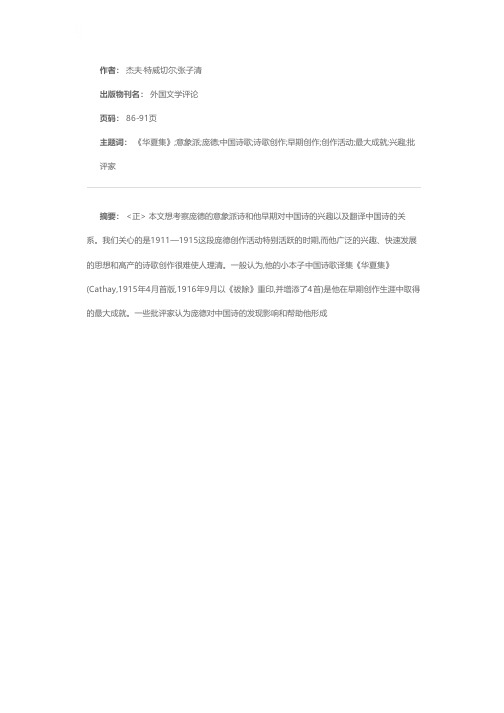
作者: 杰夫·特威切尔;张子清
出版物刊名: 外国文学评论
页码: 86-91页
主题词: 《华夏集》;意象派;庞德;中国诗歌;诗歌创作;早期创作;创作活动;最大成就;兴趣;批评家
摘要: <正> 本文想考察庞德的意象派诗和他早期对中国诗的兴趣以及翻译中国诗的关系。
我们关心的是1911—1915这段庞德创作活动特别活跃的时期,而他广泛的兴趣、快速发展的思想和高产的诗歌创作很难使人理清。
一般认为,他的小本子中国诗歌译集《华夏集》(Cathay,1915年4月首版,1916年9月以《祓除》重印,并增添了4首)是他在早期创作生涯中取得的最大成就。
一些批评家认为庞德对中国诗的发现影响和帮助他形成。
- 1、下载文档前请自行甄别文档内容的完整性,平台不提供额外的编辑、内容补充、找答案等附加服务。
- 2、"仅部分预览"的文档,不可在线预览部分如存在完整性等问题,可反馈申请退款(可完整预览的文档不适用该条件!)。
- 3、如文档侵犯您的权益,请联系客服反馈,我们会尽快为您处理(人工客服工作时间:9:00-18:30)。
Pound and Chinese Classic Poems1.The coming of image and Chinese poems’ influence on Pound1.1The social and literature backgroundAt the end of the 19th century and the beginning of 20th century, the west world is changing dramatically. The United States becomes richer and richer, and the social revolution is going on. Old moral codes were breaking down. “Meanwhile, the loss of faith, which began noticeably with Darwin’s theories of evolution and was intensified by the development of modern science, continued with a greater intensity into this century. …In short, people found themselves living in a spiritual wasteland, as T. S. Eliot’s epochal poem suggests, where life was a meaningless and futile affair and man felt homeless, estranged and haunted by a sense of doom.” [1] “The traditional English poetics with its iambic pentameter, its verbosity, and extra-poetic padding can not meet the need of expressing the temper of the age.”[2] In order to change this situation, a small group of English and American poets, such as T. E. Hulme and Ezra pound, came together in the first years of this century to work out some new way of writing poetry. Imagists proposed, “something like an imagist manifesto …in 1912 in which Pound and Flint laid down three imagist poetic principles: (1) Direct treatment of “thing”, whether subjective or objective: (2) to use absolutely no word that does not contribute to the presentation; (3) as regarding rhythm, to compose in the sequence of the musical phrase, not in the sequence of a metronome.”[3]1.2Chinese poems’ influence on Pound“In 1913 he (Pound) became the literary executor of Ernest Fenollosa, the noted American Orientalist, and began his fruitful study of the Chinese language and ancient Chinese culture.”[4]In Fenollosa’s work, Pound found that “Chinese poem is, by virtue of the ideographic and pictographic nature of Chinese language, essentially imagistic poetry. The Chinese language is concrete and direct and metaphorical, and Chinese poem is noted for its virile laconism and austere pregnancy (which alsocharacterize imagist poetry). The history of Chinese writing conditioned Chinese literature to its conciseness and precision. To make fewer words do more was the cherished aim of literary training in ancient china. Since images need fewer connectives and convey more, it is only natural that they are built into the very texture of classical Chinese poetry. They either juxtapose with, or superimpose or melt into each other, and often form clusters of fused ideas impregnated with power and energy.”[5] It is no wonder that Ezra Pound found a “"New Greece in the culture of China", and a model to recreate,to emulate and to surpass. ·Inspired by the Classical poems Chinese Poetry,Pound found a way to break away from“the poetics of motional slither”, to mold a brand new kind of poetry,and to launch an American cultural revolution.”[6]One points should be pointed out is that some scholars over emphasized Chinese classical poems s’ influence on Pound and imagism. According to the study of Yuan Xin, the ideas of imagism of Pound has already set up before he started to study Chinese classical poems s and Chinese literature. “It is Pound’s principle of imagism that caused him to be interested in acquiring, understanding and translating Chinese classical poems s, and Chinese classical poems s enhanced his belief in imagism. ”[7] Imagist poems inherit some ideas from Chinese classical poetry, but “the imagist movement drew from a variety of poetic traditions. Greek, Provencal, and Japanese poem are among the many acknowledged sources of imagism and Pound’s poetry.”[8] It is at this point that Chinese classical poem can be compared with imagist poems.2. A comparative study of Image between Chinese classical poems s and pound’s poemsIn this section, the key idea of imagist movement—Image will be discussed to show the common ground and difference between Chinese classical poems s and pound’s poems2.1the common ground of Chinese classical poems s and pound’s poems2.1.1 the ideas about imageAs the name of the movement--Imagism shows, Image is the core of the movement. “T. E. Hulme said that the image must enable one “ to dwell and linger upon a point of excitement, to achieve the impossible and covert a point into a line.”[9] Pound defined an image as that which presents an intellectual and emotional complex in an instant of time, and later he extended this definition when he stated that an image was “a vortex or cluster of fused ideas”“endowed with energy.””[10] In Chinese classical poems s, Image also plays an important role for a very long time. The images in the Chinese classical poems express the “subtle momentary felling”and “a complex felling”[11]or “Image is pure sensatory. it is the concretion of felling.” Or “image is the impression of the things left in the mind.”[12] So it is easy to found that the west and east have something in common to some extent.2.1.2 The presentation of image.In this section, the method of presentation, like direct treatment, and superposition, used both in Chinese classical poems s and Pound’poems will be discussed.2.1.2.1 Direct treatmentThe first principle of Imagist, “with its emphasis on direct treatment, indicates a desire to make the expression resemble the “object” as closely as art can make it. By “direct,”Pound means no fuss, frill, or ornament.”[13] In his work “Osiris”, Pound explained this principle. He holds that modern poems should be “closer to the thi ng; beauty of the thing should replace rhetoric and frilled paper decoration.” The language used in the poems should be harder, nearer the bone, and like granite”. [14]That requires poets do not use ornament or emotion to decorate the thing but present the thing before the reader, just like present a sculpture before a visitor. Pound found that “Chinese poets have been content to set forth their matter without moralizing and without comment”[15] He wrote in his works: If you want some European to give a definition of something, the definition they gives will deviate from the simple thing and move to a remote place where nobody knows. If you ask him what red is, he will definite it as a kind of color. If you ask him what color is, He will tell you it is a kind of libration or refraction of light, or the separation of spectrum. While Chinese defines red in another way: “red: cherry, rust or flamingo.” That means Chinese treat things directly without any ornament.[16]2.1.2.2 Juxtaposition of imagesOne of the characteristics in classical poems Chinese poem is the juxtaposition used especially in ”jue ju"(quatrain) and”Lu shi'(eight- line verse). The following is one example: [17]月落乌啼霜满天江枫渔火对愁眠The moon goes down,Crows caw,frost takes the sky,Sleepy gloom weaves,River maples and fishing lanterns.In the original poem, the images---moon, Crows, frost, River maples, fishing lanterns---are presented one after another. All these images are juxtaposed. Pound named this kind of technique as “superposition” and he used it a lot in his writing. One does not have to search far for an apparent example of this sort in Pounds famous imagistic couplet, In a Station of the Metro which immediately shows similarity in technique to the above classical poems couplet.The apparition of these faces in the crowd;[18]Petals on a wet, black bough.The images “apparition of these faces” and “Petals on a wet, black bough” are juxtaposed too.The Superposition of images has created a special effect---cinematic montage effect. Autumn Thoughts by Ma Zhiyuan(1260-1341 A. D.) might serve to illustrate:天净沙·秋思[19]枯藤老树昏鸦,小桥流水人家,古道西风瘦马。
